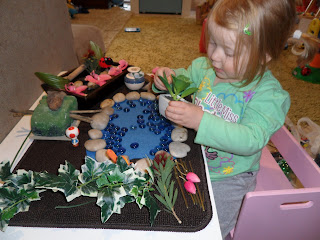The idea of using objects that children are normally told to "look at but don't touch," as well as fun and sensory items like smooth rocks and shiny glass pebbles, really excited me and made me look outside the box as to what could be used for play and thus learning.
(For this, I really thank the wonderful ladies from Homemade Rainbows and please stop by their facebook page to say hello.)
For this playset I purchased a cheap brown bathmat for the base (Reject Shop), some white stones and blue glass decorator pebbles ($2 shop) and then collected the rest of the items from around the house and garden
It was so exciting to be allowed to play with the little pots and fake plants that you're often told to leave alone
Exploring the different textures and the weight of the porcelain. Different to plastic.
Loving the freedom to explore, touch, pretend, manipulate etc. She insisted it be put on the floor so she could play more freely
Come here little lady bug
These types of play sets are so versatile as they can be set up differently every time
It was tricky making a teepee from sticks, but little Toadie needed a shelter
Some tips:
- If you love this type of play but you don't have the time nor the inclination to make one of these for yourself, go over to Handmade Rainbows where you can purchase one of their many amazing and inspiring designs. Remembering that each one is pretty much a one-of-a-kind as they all contain different items.
- See this playset in use in a different way on one of our playdates
- Talk with your child about what they are experiencing. This will help them understand the physical and mental processes they are going through as well as giving them the vocabulary to describe it.
- Use new language and descriptive words like, "porcelain" This will help with their language development.
-Ask questions to help connect their understanding and use vocabulary to give them words to describe what they're exploring, eg. "What could this be used for?" "What is this made out of?" "How should we handle it?" "Why are you making a home for Toadie?" etc
- As your child may be playing with an exploring fragile items, take the time to talk with them about how to handle them carefully and what might happen if they drop it or bend it etc
Debs :)









